Digital texts can be floating around in all kinds of apps. Getting interesting passages out of there to write notes with them, for example, can be quite annoying and fragmented. Readwise wants to be the missing piece in the middle here, bundling highlights from Kindle or Apple books, PDF, articles on websites or even podcasts in one place. I took a look at it.
The problem with digital texts
I read digital texts in many different ways. One is RSS feeds, which I use instead of social media to read exciting articles. Often, though, I don’t have time to read an article at that moment and save it to Instapaper to read it later. Then, of course, there are eBooks. Sure, I read a lot of “real” books, too. Still, over the last ten years, eBooks have become an integral part of my reading process. And I buy them wherever I can get them at the best price. Usually that’s Amazon, the Apple Books store, or – in the case of indie authors – simply the person’s website.
So I read things on all possible corners of the internet and of course I want to do something with it. If I just read a text, it might be nice for the moment, but it’s not very helpful in the long run. Often, even after months, I still have a feeling for a text and a rough idea of what was in it, but I certainly don’t get the argumentation or details straight. So I have to make sure that I not only read texts, but also process them.
The first step for me is always to mark interesting parts of the text. Especially with digital texts this works very well. There’s just one problem when you read content in many different places: every service, every app has its own system for exporting highlights. And usually nothing is automated. So I’d have to keep digging around in apps or web interfaces if I wanted to get to my highlights. Not exactly a workflow that you would call intuitive and uncomplicated. And that, of course, reduces the chance that you’ll do it at all.
This is where Readwise comes in. Readwise is a web service that aims to solve the problem I just described. You can connect Readwise to other services and then grant Readwise access to the service in question. Readwise then takes care of importing highlights. A simple example is Instapaper. Almost all articles that I find interesting first end up in Instapaper. I then read them there and highlight sections. Readwise then imports them automatically, so I don’t have to do it myself. In the same way I’ve connected my Apple Books and Kindle library, so Readwise can import highlights from books I have there. So instead of exporting highlights for three services and each article or book myself, Readwise does it for me automatically.
Import possibilities as far as the eye can see
So far, so good. But what if I don’t use any of these three providers? Then there is at least a pretty good chance that Readwise can still help. If there’s one thing that impresses me about Readwise, it’s how many implementations they’re working on, or are already on board, respectively. In addition to Apple Books, Kindle and Instapaper, they currently have Pocket, Twitter, Medium, Feedly and Hypothes.is, Google Play Books and O’Reilly Learning, as well as the Command browser, which specializes in intensive text work.
But these are only the websites from which highlights are imported directly. In addition, there are a myriad of other ways to import readings into Readwise. For example, you can connect your Kindle via USB to have the file with all the highlights directly read and imported. Or have it emailed to Readwise. Another way is to upload a CSV file (i.e. from Excel). There is also a workaround for the (audio) book flatrate Scribd to be able to import highlights despite the lack of an API.
But that’s not all. Currently, a feature is in beta that allows PDFs to be uploaded so that highlights and comments can also be imported from PDFs. Please don’t get me wrong: the services I listed above are great and it’s an impressive range. PDFs, however, would be a real gamechanger. PDF is the backbone of science, all current papers and texts (also) appear as PDF and if I had a service through Readwise to export and bundle my annotations and comments from PDFs, that would be a fantastic help. Currently the way it works is that you have to send the PDF to the address [email protected]. Of course, you have to use the same email address that you use in your account, so that Readwise can assign the PDF to the right account.
Real books on the shelf? No problem
But that’s not the end of the story either. It is also possible to either add text yourself via copy & paste or to take a picture of a section in a printed book and then upload it. In Readwise it is then possible to mark a few sentences, which are then OCR’ed. I have only tried this once so far, but it worked very well, especially because I was able to assign the correct book from a database.
But that’s all now, isn’t it? ISN’T IT?? No. There is also the Goodreads integration, Supplemental Books and Airr. Goodreads is a social network for books. You can create lists of what you’ve read and what you’d like to read, rate books, write reviews and much more (if you want to see what I’m reading, you can do that on my Goodreads profile). But beyond that, Goodreads also offers to show popular highlights for a book. You can then see which parts of a book others found particularly interesting. Now this isn’t necessarily useful if you want to strictly just collect your own thoughts. But it can be very helpful if you’re looking for inspiration or are just curious about what others found noteworthy about a book.
Supplemental Books does something very similar, showing popular highlights from books you’ve read. Where Readwise gets the highlights from is not entirely clear to me. Possibly from its own database, i.e. highlights that other users have imported. One of the most exciting integrations, however, is Airr. Airr is a podcast player that allows you to clip short sections of a podcast. It is also possible to automatically transcribe a podcast and then send parts of the transcript to Readwise. In this way, podcasts can be integrated into a text workflow. Podcasts can become a source like web pages, PDFs or books1.
Organizing highlights with tags
So there is no lack of ways to import content into Readwise. But what about organization and management? It is of little use to me if I have all the content in the world, but can’t work with it in a meaningful way.
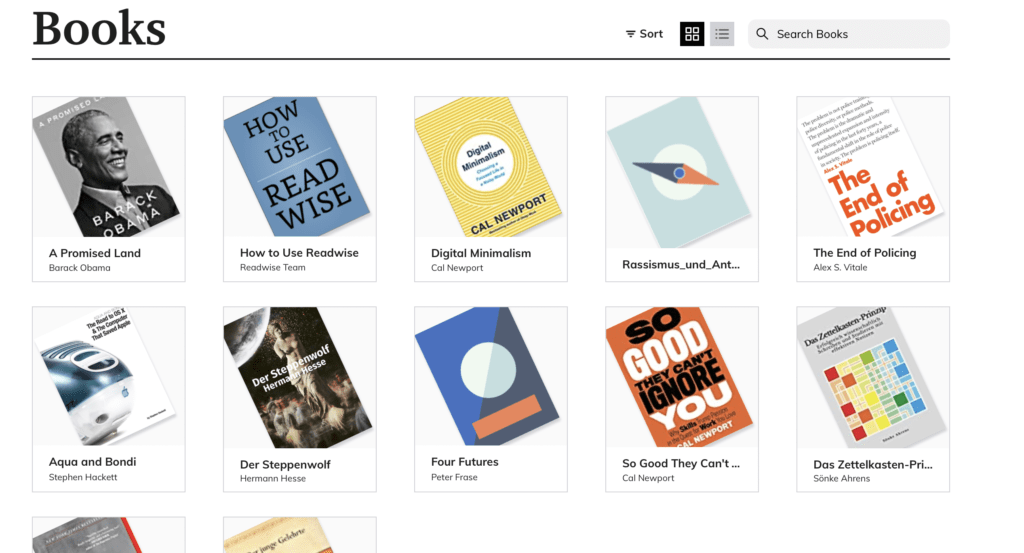
My books in cover view 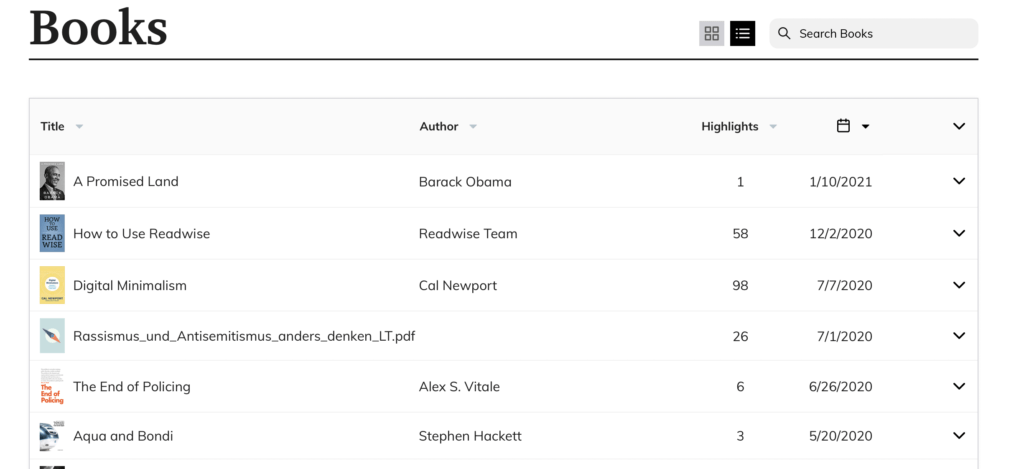
and list view
Readwise relies here primarily on a classification by media type and tags. At the same time, it becomes clear that the focus is not on working directly in Readwise. The organizational options are not elaborate enough for that. As a user, I have no possibility to organize highlights according to my own scheme. The default options are books, supplemental books, articles, podcasts, tags, favorites, discarded highlights, and highlights that you find particularly important and want to learn by using the mastery feature. So the organization options are more for browsing or looking for something now and then, not so much for implementing a complex system.
Learning with Mastery and Spaced Repition
Readwise is not only an intermediate step for the actual work. It can also be used to learn content. For this purpose there is the already mentioned Mastery feature. This makes it possible to learn highlights with the Spaced Repition method. To do this, all you have to do is click on the Mastery button that each Highlights card has and then select the word or words you want to learn, for example because it is a definition. Then the next time, the selected words are not visible. However, I could only ever make a maximum of five words invisible, so it’s not good for hiding a complete definition, for example.
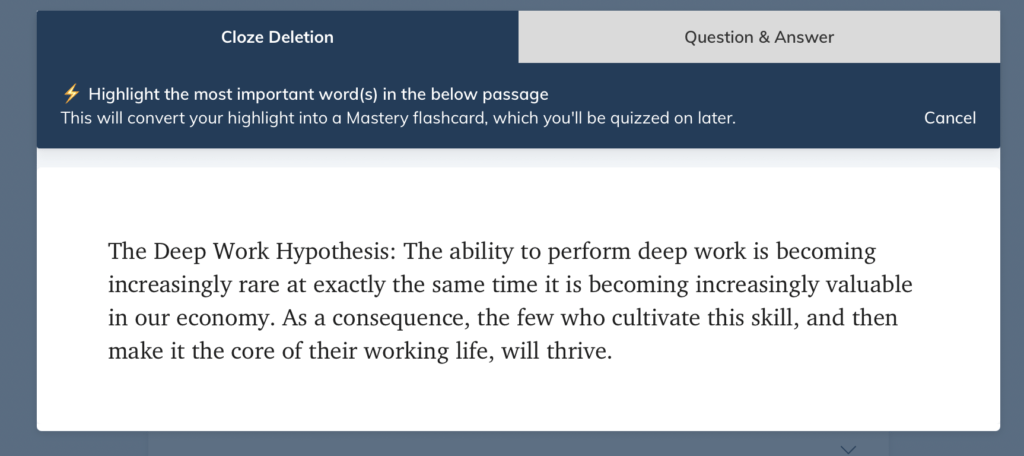
With the Mastery feature, highlights can be converted into index cards 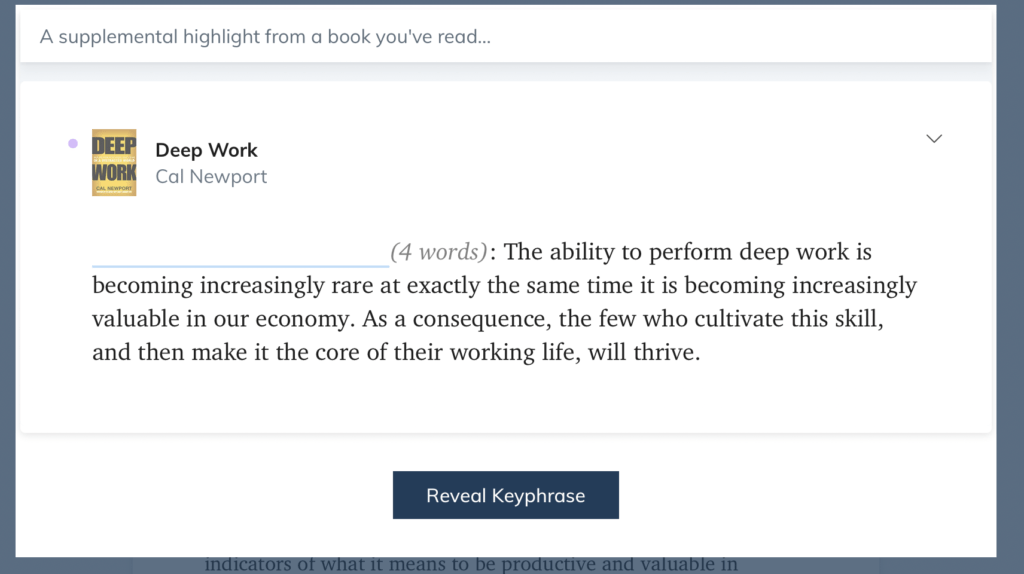
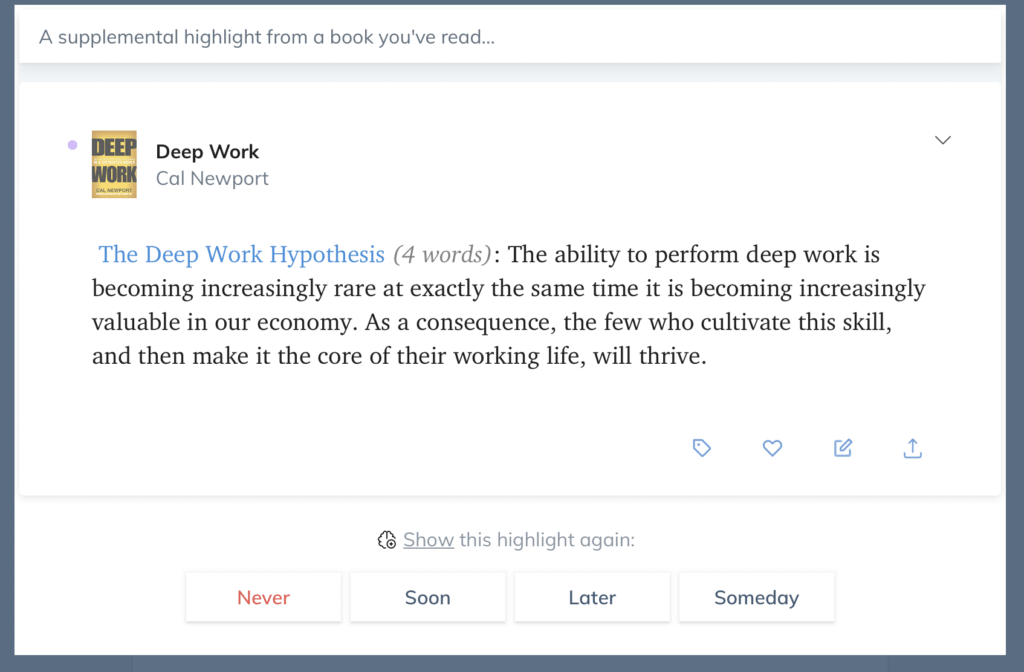
Fortunately, there is a second way to work with text sections. You can also create an index card by writing down any question and then entering the text passage or a part of it as the answer. This is a good way to learn longer sections.
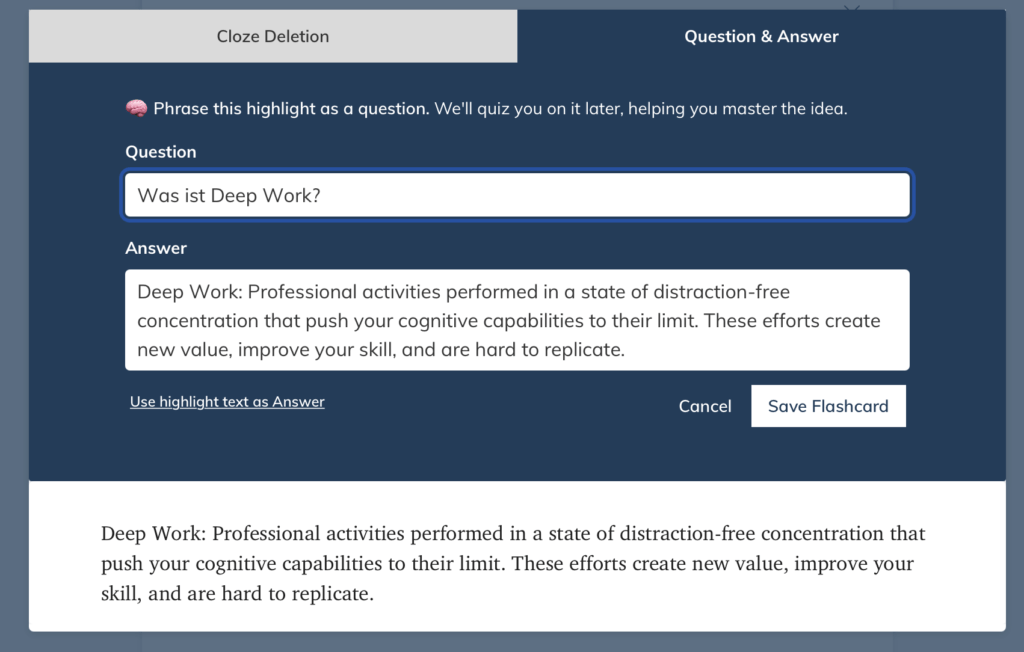
Question and answer cards can also be created 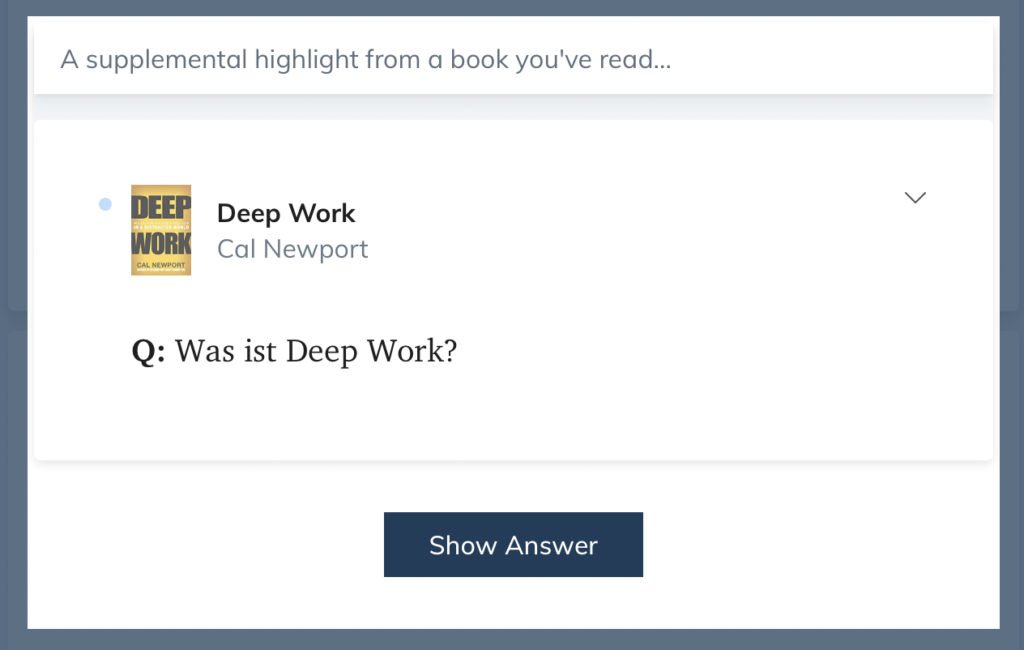
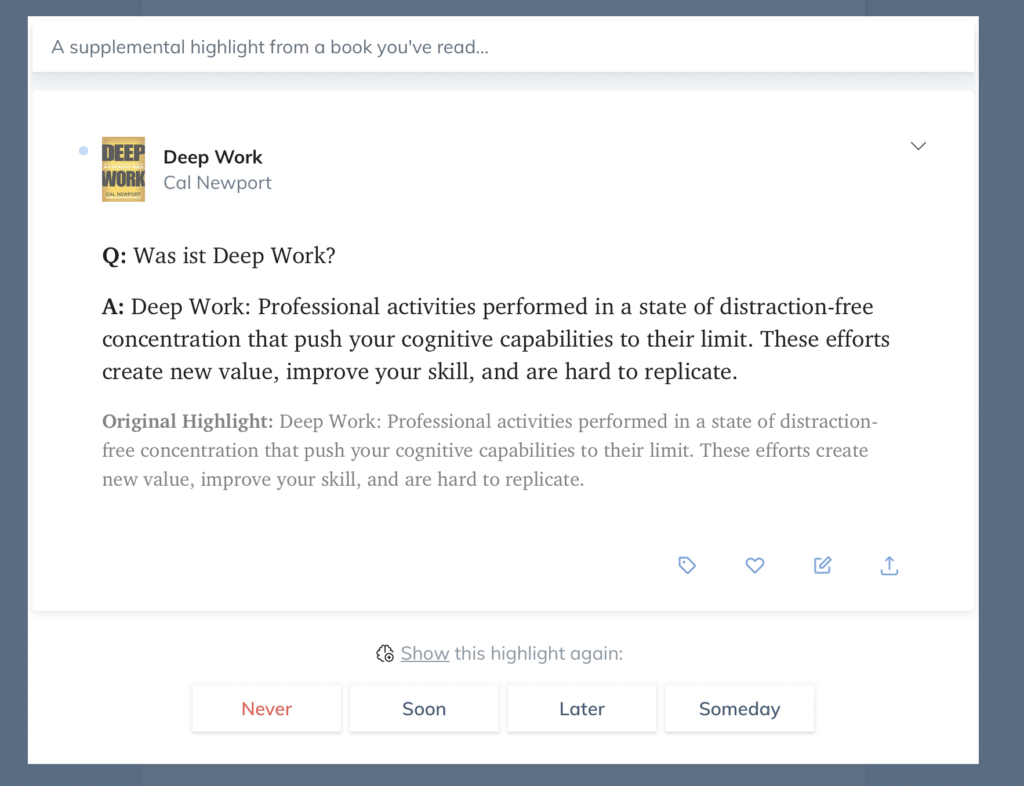
Daily highlights: Gimmick or real added value?
For me, the daily email with highlights falls more under the category “nice gimmick”. The idea is that every day at a set time you can get an email from Readwise containing five highlights (or more, can be adjusted in the settings) from the existing repertoire. In addition, you can get a sixth highlight from a book that you haven’t read, but that Readwise thinks is appropriate based on your library. For each highlight, you can then specify whether you want to keep seeing it or not. You can also add them to the highlights you want to learn and assign tags. In the settings, you can change the frequency with which certain sources are shown. You can also set whether newly added content or older content should be displayed.
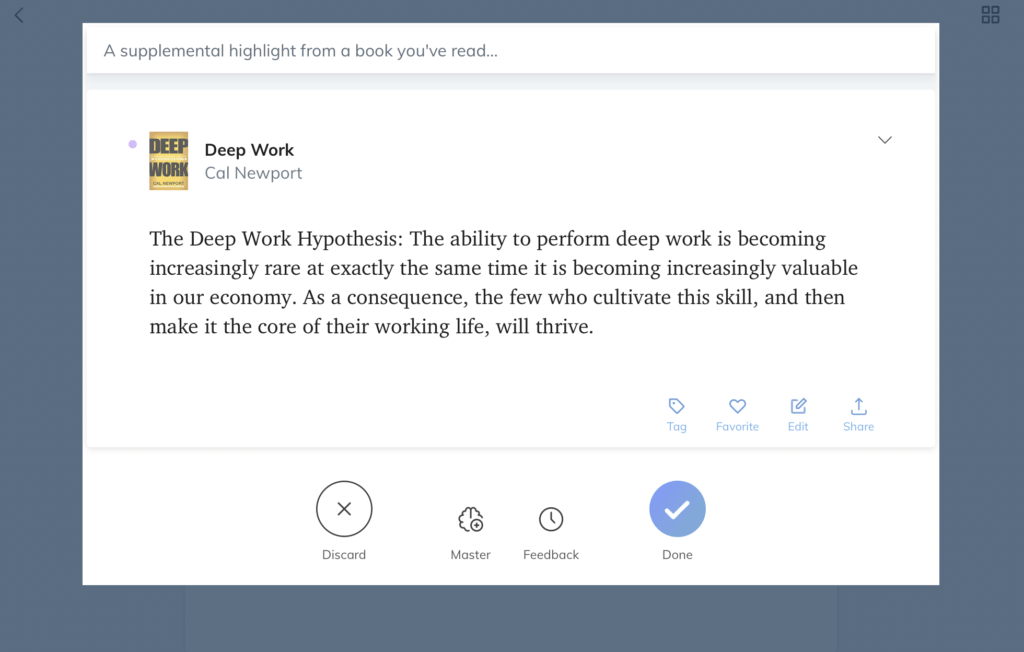
For me it’s a nice ritual in the morning, but it doesn’t have too much value. I have set the mail to be sent to me every morning at 7, so that I can do the daily run-through over my morning coffee. Every now and then I indeed stumble across interesting passages from books or articles. However, I also have the feeling that Readwise still needs to do a bit of fine-tuning here, since I quite often get the same books or articles, whereas some others from my library have not yet appeared at all. Maybe I have to experiment with the settings again.
Export to Evernote, Roam and Notion.
But if Readwise itself is not so good for organizing text passages, it needs an exit. Readwise is then the intermediary that gathers my highlights from all sorts of sources, but not the place where productive work with that text happens. Readwise has its export function for exactly this purpose. It currently works automatically for Evernote, Notion and Roam Research, three of the biggest players in this field. You can also export CSV and Markdown files manually.
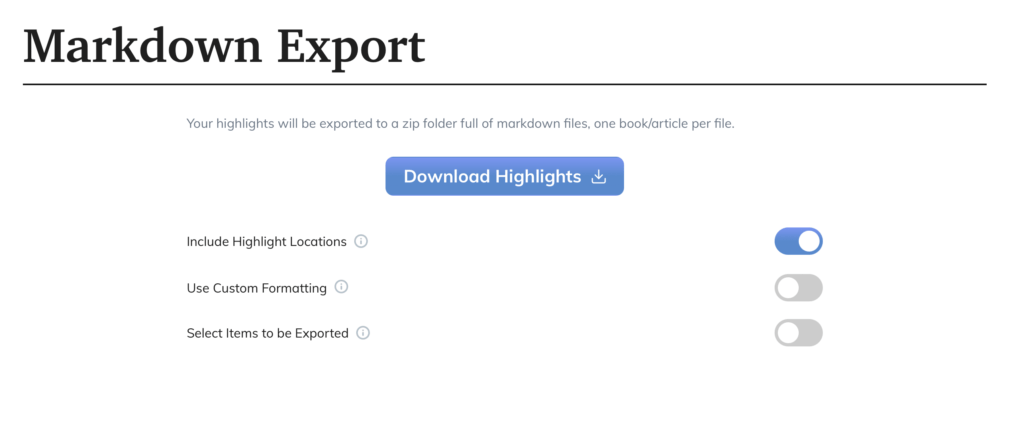
Is it useful? Do I need it?
How do I rate Readwise? Is it useful or just another subscription that you don’t use enough? First and foremost, I find the idea behind Readwise fascinating, as it addresses a real problem. People who work a lot with digital texts simply often get caught in a trap where they collect a plethora of content but don’t work effectively with it. Marking up is one thing. Generating retrievable knowledge from it or writing useful texts is something else entirely. In addition, the large platforms such as Amazon Kindle or Apple Books often do not make this second step particularly easy or intuitive. Readwise can play a decisive role here.
However, you also notice that the service is still in its fledgling stages. The web interface often takes a bit longer to load and the algorithm for highlighting also needs some work. On the other hand, I find the number of integrations already in place quite impressive and I expect more to be added in the future. In addition, if the PDF import emerges from the beta phase as a reliable feature, it would increase the usefulness especially for scientists and students d.
Educational discount and double trial period
Currently, Readwise costs $4.49 per month in the Lite version and $7.99 in the Pro version without the educational discount. I tend to think that the Lite version is not sufficient. Many of the exciting features (Tags and Notes, Export to Evernote and Notion, Mastery) are only included in the Pro version. A complete overview can be found here. The good thing, however, is that Readwise offers a quite generous educational discount of 50%. As I understand the website, you just have to have something to do with a university. Study there, work there, still have a mail address left. A mail to [email protected] seems to be enough.
If you want to have a look for yourself, you can do so via this link. If you register, you will get an extra month of trial period (60 days instead of the normal 30 days) and you will also give me a month to test it. Fair, isn’t it?


Ein Kommentar